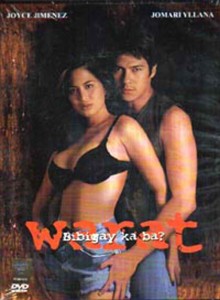Disclaimer: Apologies to all the women in the world for the potentially misogynistic contexts that may emerge from my usage of the loaded term “warat” in this article.
Warat is a common Filipino expression often interchanged with “wasak.” It means “broken” or “destroyed” in English, but is also a slang word for “drunk and high on an assortment of drugs” or a devirginized girl.
“Warat” is also the title of a 90’s bold movie starring Joyce Jimenez.

My years of exposure to the devious underworld of 90’s bold movies — my exposure to videos of naked women — has supposedly corrupted my soul and turned me into a depressed adult who compulsively cries at night when recalling scenes from “Balahibong Pusa” and “Sutla.” These transient images carve themselves into memory, haunting men like naked sirens, beckoning them towards madness. 90’s soft-porn cinema: a truly great evil.
At least, that was what my values teacher told me about bold movies. Thankfully, although many hours of my youth were spent in isolation and many VHS and Betamax devices have malfunctioned after much fast-forwarding and rewinding, I still don’t have a corrupted soul.
The absence of the “artistic factor” was a common criticism tossed around by regulatory boards and “purists” alike to condemn the bold cinema trend of the 90’s. However, I’m not entirely sure what these people meant by “artistic.”
One of the most debated topics in aesthetics and censorship legislation is the nature of art. What is art? While a fair number of people are aware of the principles of art (balance, contrast, proportion), not many are aware of the standard “approaches” used to define what is artistic. Is a 90’s bold movie artistic? Is porn artistic?

“All artistic creation is a form of imitation.” – Plato
One of the earliest approaches to art was by Plato. Plato believed that the primary element in determining artistic quality is mimesis or an artist’s ability to mimic or re-produce reality. In other words, an artwork’s realism is what defines its artistic quality.
By this standard then, the bold movies of the 90’s are definitely inferior to “Jersey Shore,” Hayden Kho, and contemporary amateur porn. But via the same standard, in terms of realism, “Warat: Bibigay Ka Ba?” is actually more artistic than any movie that implies that Carla Abellana could actually be attracted to Jorge Estregan Jr.

“Works of art so often arise from some deep personal feeling or crisis in the lives of their creators that emotion itself is commonly taken as the defining characteristic of art.” – Leo Tolstoy
Art is not art unless it is able to transfer raw emotions. According to Leo Tolstoy, an artist’s ability to make the audience feel what he feels should be the standard of art. This premise, however, postulates that artistic intention and audience reaction is the highest standard of artistic quality.
If a poem about something sad was written in a way that makes a reader sad too, then by this standard, it is art. If a scene exhibiting sexually aroused individuals makes the audience aroused too, it is artistic. With regard to “Warat: Bibigay Ka Ba?,” when Joyce Jimenez was moaning and writhing to express her sexual arousal while she was having make-believe intercourse with an actor, many viewers were also sexually aroused. Needless to say, the scene was successful because it seemed authentic enough to generate an authentic response.

“Art is something that is both functional and aesthetically pleasing.” – Shelley Esaak
As the quote clearly explains, another measure of artistic value is how efficiently an artwork functions as a tool. If a creator’s intention in making an artwork like “Poleteismo” is to bring attention to certain religious issues, then it was successful because it got people talking about religious issues.
Let’s be honest and say that “Warat: Bibigay Ka Ba?” had no intention to create a paradigm shift in cinematic art. In fact, the plot was mostly an excuse to get naked and start intercourse-ing. But that was precisely what the intended function was – to cause sexual arousal and, in some situations, sexual satisfaction. “Warat: Bibigay Ka Ba?” can be considered as something that is both functional and aesthetically pleasing.

If one can make an argument that can somehow imply that the movie “Warat: Bibigay Ka Ba?” is art, then there is something seriously odd about the nature of art.
But that, for me, is what makes art both interesting and relevant. Art evolves and changes. This state of transience that exists in all forms of art is what encourages experimentation, discourse, criticism and creation. Even in conservative and restrictive societies, art continues to exist as a venue and as a channel for human freedom.
That is why I believe that art should be free from rigid definitions – and definitely from morality-based regulation. Unfortunately, a common standard many regulatory boards measure art by is via a distorted, outdated, dogmatic and biased moral standard.
Ironically, the most common reference material for morality – the Bible – is itself full of incest, infanticide, torture, and genocide; things that are definitely far worse than even the most indulgent fucking scene in 90’s bold cinema.
But I digress.
Many of you may disagree about the artistic qualities of “Warat” mentioned here. Feel free to state your opinion on the following issues:
Is “Warat” art? By what artistic standard should we measure “Warat?” Should movies and music be regulated? Is “Warat” even a good movie? If “Warat” is not a good movie, can it still be art? Does art have to be good to be art? Should “Warat” have a sequel, how a bout a re-make? Which would you rather see, “Warat: Bibigay Ka Ba?” or “Spoliarium?”


Biutyful movie
Actually, in the point of view of Plato, he regards an artist's work as the lowest kind. That's why for him, he considers a work of art as merely imitation. For him art is an imitation of reality and reality as an imitation of a main idea. So yes, "Warat" may be an art form in Plato's terms, but in his terms an artwork that is not highly regarded. 🙂
Perhaps I need to pick up a copy of this movie to be able to debate comprehensively about its artistic merits (or lack of). Links to your porn stash… er, source material, are much appreciated. xD
Fr. Nick Cruz might have a copy at the Comm. Arts Department in Ateneo.
Rumor has it he has the largest collection of pr0n…err…art films in the area, second only to Ricki Lee 🙂
If the dear Brothers were as enlightened as the Jesuit fathers, my education would be vastly different, enriched by such oeuvres like "Anakan Mo Ako".
We could extend the "art" or "porn" argument to the boundaries that people insist demarcate "erotica" and "porn", as if the latter is the base, uneducated cousin of the former. I think "erotica" is a self-congratulatory label applied to "well-made" porn to make people feel morally superior and cultured about watching people fuck. It's really rather snooty.
It's almost midnight. Let's do some further "research".